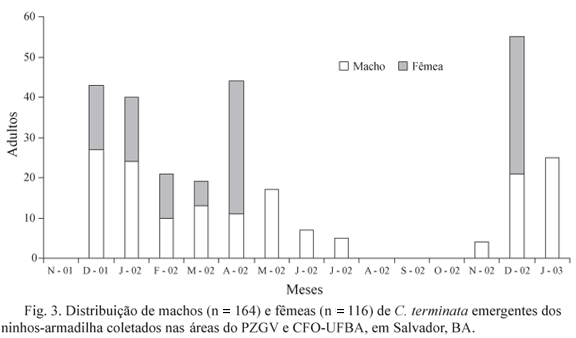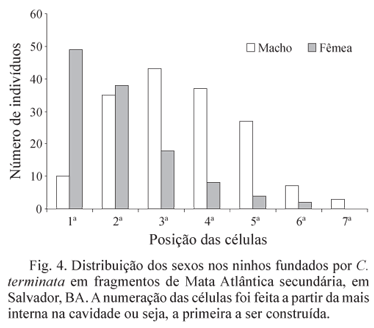Ninety-five nests of Centris (Heterocentris) terminata Smith were collected in trap-nests, during November/2001 and January/2003, at two fragments (PZGV e CFO-UFBA) of secondary Atlantic Forest, in Salvador, Bahia State (13º01’ W e 38º30’ S). The highest nest frequencies occurred from December to February (summer), with no nests foundations from August to October (winter - early spring). Two-hundred eight adults emerged from 347 brood cells, being 164 males and 116 females (1: 0.42). During the study period sex ratio was male biased (c2 = 9.342; gl = 10; P < 0.05). C. terminata nested in holes with diameters 6, 8, 10 mm, but 84,2% were constructed in 8 and 10 mm. nests had one to seven cells arranged in a linear series with the cell’s partitions built with a mixture of sand and resin or oil. Male is significantly smaller than female, which emerges from the first cells constructed. Immature mortality occurred in 14.1% of brood cells (n = 49), of which 13.0% were due fail in development and 1.2% due to parasitism of Coelioxys sp. (Hymenoptera: Megachilidae) e Tetraonyx sp. (Coleoptera: Meloidae). In the study site, weather, mainly pluviosity, rather than natural enemies influenced seasonal population abundance. The long period of nesting activity, local abundance and usage of trap nests, suggest the potential of C. terminata for management aiming at pollination of native and cultivated plants.
Solitary bee; nesting biology; nest architecture

 Trap-nests used by Centris (Heterocentris) terminata Smith (Hymenoptera: Apidae, Centridini) at secondary Atlantic Forest fragments, in Salvador, Bahia State
Trap-nests used by Centris (Heterocentris) terminata Smith (Hymenoptera: Apidae, Centridini) at secondary Atlantic Forest fragments, in Salvador, Bahia State





